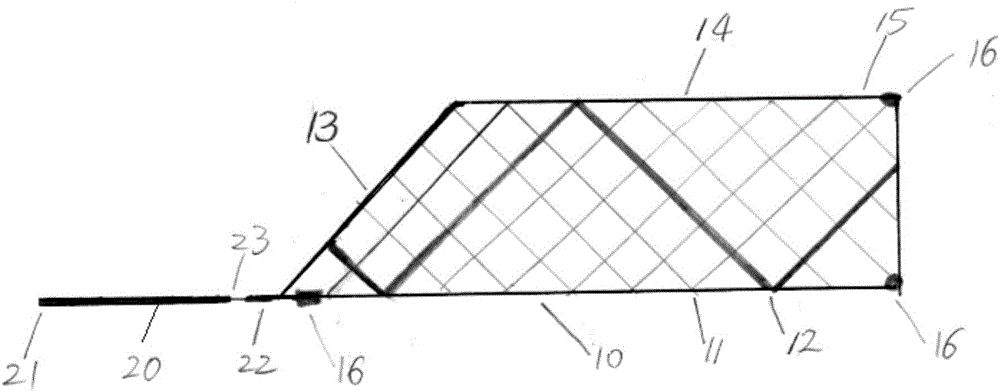Intravascular stent of composite structure
A technology of composite structure and inner stent, applied in the field of intravascular stent with composite structure, can solve the problems of increasing the difficulty of operation, increasing the shortening rate of the stent, and difficult to maintain the designed shape of the stent, achieving superior bending resistance and fatigue performance and successful operation. The effect of improved efficiency and improved controllability
- Summary
- Abstract
- Description
- Claims
- Application Information
AI Technical Summary
Problems solved by technology
Method used
Image
Examples
Embodiment 1
[0051] Such as figure 1 The stent of the present invention is shown as a thrombus removal device for treating acute cerebral apoplexy. The doctor slowly pushes the catheter with the stent 10 inside to pass through the thrombus, and then presses the proximal end 21 of the delivery guide wire 20 fixed together with the stent, and slowly The catheter is withdrawn slowly so that the stent is released and the thrombus is contained. At this time, the delivery guide wire 20 is slowly withdrawn, and finally the thrombus is sent to a guide catheter with a larger inner diameter, and the guide catheter with thrombus is withdrawn from the patient's body. Because the distal end 15 of the stent is retracted, even when the guide wire 20 is retracted, a small thrombus may break away from the main thrombus. Flow to small distal vessels, causing more vessel blockages. After the thrombus was taken out, the patient's blood flow was unblocked immediately, and the symptoms were relieved. When us...
Embodiment 2
[0053] The stent of the present invention is used as a stent to expand narrow or blocked blood vessels, such as figure 2 As shown, the doctor infuses the catheter with the stent 10 pressed inside through the narrow blood vessel, then presses the proximal end 21 of the delivery guide wire 20 fixed with the stent, and slowly withdraws the catheter. At this time, the stent starts from the distal end. It is gradually released to dilate the narrowed blood vessels, and the patient's blood flow is immediately dredged, and the symptoms are relieved. If the doctor is not satisfied with the position of the stent, he can withdraw the stent to the catheter, readjust the position of the catheter, and then release the stent again. Finally, the middle part of the stent is placed on the narrowed blood vessel. Due to the expansion and support of the stent, the actual inner diameter of the narrowed blood vessel increases and the blood flow increases. Gradually increased, the patient's symptoms...
Embodiment 3
[0055] When the stent is placed in the blood vessels of the lower extremities (such as the femoral artery, hip artery, popliteal artery, etc.), it is very challenging. When people walk or squat, the stent will be greatly compressed and bent. Once the stiffness and bending resistance of the stent are poor , the probability of stent fracture is high. A specially designed stent of the present invention is very suitable for dilating narrowed lower extremity blood vessels. Such as image 3 As shown, it is characterized in that the weaving density of the main body of the stent is greater than that of the two ends. The characteristics of braided stents are that the higher the braiding density, the stronger the stiffness of the stent, the higher the radial force of the stent, and the better the bending resistance of the stent.
PUM
| Property | Measurement | Unit |
|---|---|---|
| diameter | aaaaa | aaaaa |
| diameter | aaaaa | aaaaa |
| thickness | aaaaa | aaaaa |
Abstract
Description
Claims
Application Information
 Login to View More
Login to View More - R&D
- Intellectual Property
- Life Sciences
- Materials
- Tech Scout
- Unparalleled Data Quality
- Higher Quality Content
- 60% Fewer Hallucinations
Browse by: Latest US Patents, China's latest patents, Technical Efficacy Thesaurus, Application Domain, Technology Topic, Popular Technical Reports.
© 2025 PatSnap. All rights reserved.Legal|Privacy policy|Modern Slavery Act Transparency Statement|Sitemap|About US| Contact US: help@patsnap.com



